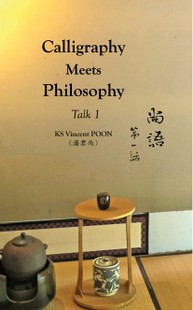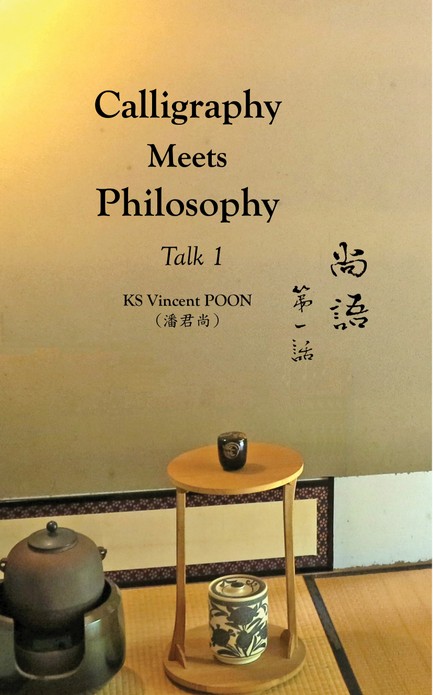The Great Learning (大學)
The following information is published in the book "Calligraphy Meets Philosophy – Talk 1":

Calligraphy Meets Philosophy - Talk 1 尚語 - 第一話
by KS Vincent POON (Aug. 2022)
ISBN 978-1-989485-30-9
Content is the soul of an artwork.
Thus, catching the soul of Chinese calligraphy requires understanding the literary contents. To facilitate this, the Calligraphy Meets Philosophy series presents traditional Chinese calligraphy alongside line-by-line translated texts with remarks and footnotes.
Calligraphy Meets Philosophy – Talk 1 (《 尚語∙第一話 》) includes three calligraphic works and their translations: Heart Sutra (《般若波羅蜜多心經》), Great Learning (《大學》), and Zhuangzi - The Secret of Caring for Life (《莊子∙養生主》). It also includes Revisions to “An English Translation and the Correct Interpretation of Laozi’s Tao Te Ching”.
WorldCat/Library: [WorldCat] [U of Oxford] [U of Cambridge] [Harvard U] [National Palace Museum Taiwan] [HKU]
On this page, original footnotes and remarks have been removed. Translation of the first six lines is provided here as a preview.
Translation (revised Aug. 2022)
The original classical Chinese of Great Learning and its text arrangement below follow Zhu Xi’s (朱熹) venerable Commentaries on the Four Books (《四書集注》)(1). Hence, the order of the paragraphs is slightly different than that seen in Liji’s (《 禮記 》).
This English translation amends numerous common misinterpretations in other English interpretations, including that by the revered James Legge(2) and two online renditions by A. Charles Mueller and Robert Eno(3). With clear and concise language, it aims to facilitate a correct understanding of this foundational Confucian text.
English Interpretation
by KS Vincent Poon (潘君尚)
Original Chinese Text
The Fundamental Way (道) of the Great Learning is to enlighten (明) one’s inherent splendid virtue (明德), to revitalize (親,新)(4) the people, and to continuously pursue these endeavours until one rests and resides (止) in the highest level of excellence (至善).
1. 大學之道,在明明德,在親民,在止於至善。
With knowing what to pursue and where to ultimately rest in, one then (后) has steadfast determination (定). With steadfast determination, one then can (能) be in a state of unmoved tranquillity (靜). With unmoved tranquillity, one then can be at ease (安) under any circumstance. With being at ease under any circumstance, one then can deliberate (慮) with great care. With deliberating with great care, one then can attain (得) the highest excellence.
2. 知止而后有定,定而后能靜,靜而后能安,安而后能慮,慮而后能得。
All things have their respective foundations (本) and ramifications (末); all affairs have their own conclusions (終) and beginnings (始). If one knows which comes before and which comes after, then one shall not be far from The Fundamental Way (道) of the Great Learning.
3. 物有本末,事有終始,知所先後,則近道矣。
Those in the past who wished (欲) to enlighten the inherent splendid virtues throughout (於) all under Heaven first governed (治) their states (國) well. Those who wished to govern their states well first brought good order (齊) to their families. Those who wished to bring good order to their own families first cultivated (修) their own selves. Those who wished to cultivate their own selves first brought about propriety (正) in their minds (心). Those who wished to bring about propriety (正) in their minds first developed honesty and sincerity (誠) in their thoughts (意). Those who wished to develop honesty and sincerity in their thoughts first pursued their knowledge (知) to the utmost degree (致). To pursue knowledge to the utmost degree lies in examing all matters and principles to the greatest extent (格物).
4. 古之欲明明德於天下者,先治其國;欲治其國者,先齊其家;欲齊其家者,先修其身;欲修其身者,先正其心;欲正其心者,先誠其意;欲誠其意者,先致其知,致知在格物。
When all matters and principles have been examined to the greatest extent, then one’s knowledge can be pursued to the utmost degree. When one’s knowledge has been pursued to the utmost degree, then one’s thoughts can develop honesty and sincerity. When one’s thoughts have developed honesty and sincerity, then one can bring about propriety in one’s mind. When one has brought about propriety in one’s mind, then one can cultivate one’s own self. When one has cultivated one’s own self, then one can bring good order to one’s own family. When one has brought good order to one’s own family, then one can govern the state well. When one has governed the state well, one can then rule and settle all under Heaven.
5. 物格而後知至,知至而後意誠,意誠而後心正,心正而後身修,身修而後家齊,家齊而後國治,國治而後天下平。
From the Son of Heaven to the ordinary layman, everyone (壹) takes the cultivation of oneself as one’s foundation. For one to have a disorderly (亂) foundation yet end up (末) to govern well is not possible indeed (矣). What one considers very important (厚), yet one takes it lightly (薄); what one considers trivial (薄), yet one takes it with great importance (厚); such instances never existed. This is called knowing one’s foundation; this is called pursuing knowledge to the utmost degree.
6. 自天子以至於庶人,壹是皆以修身為本。其本亂而末治者否矣。其所厚者薄,而其所薄者厚,未之有也。此謂知本,此謂知之至也。
7. 《康誥》曰:「克明德。」《太甲》曰:「顧諟天之明命。」《帝典》曰:「克明峻德。」皆自明也。
8. 湯之 《 盤銘 》 曰:「茍日新,日日新,又日新。」《康誥》曰:「作新民。」
9. 《詩》曰:「周雖舊邦,其命惟新。」是故君子無所不用其極。
10. 《詩》云:「邦畿千里,惟民所止。」《詩》云:「緡蠻黃鳥,止于丘隅。」子曰:「於止,知其所止,可以人而不如鳥乎?」
11. 《詩》云:「穆穆文王,於緝熙敬止!」為人君,止於仁;為人臣,止於敬;為人子,止於孝;為人父,止於慈;與國人交,止於信。
12. 《詩》云:「瞻彼淇澳,菉竹猗猗。有斐君子,如切如磋,如琢如磨。瑟兮僩兮,赫兮喧兮。有斐君子,終不可諠兮!」「如切如磋」者,道學也;「如琢如磨」者,自修也;「瑟兮僩兮」者,恂慄也;「赫兮喧兮」者,威儀也;「有斐君子,終不可諠兮」者,道盛德至善,民之不能忘也。
13. 《詩》云:「於戲前王不忘!」君子賢其賢而親其親,小人樂其樂而利其利,此以沒世不忘也。
14. 子曰:「聽訟,吾猶人也,必也使無訟乎!」無情者不得盡其辭。大畏民志,此謂知本。
15. 此謂知本,此謂知之至也。
16. 所謂誠其意者:毋自欺也,如惡惡臭,如好好色。此之謂自謙。故君子必慎其獨也!
17. 小人閒居為不善,無所不至。見君子而后厭然,揜其不善,而著其善。人之視己,如見其肺肝然,則何益矣。此謂誠於中,形於外,故君子必慎其獨也。
18. 曾子曰:「十目所視,十手所指,其嚴乎!」
19. 富潤屋,德潤身,心廣體胖,故君子必誠其意。
20. 所謂脩身在正其心者,身有所忿懥,則不得其正;有所恐懼,則不得其正;有所好樂,則不得其正;有所憂患,則不得其正。心不在焉,視而不見,聽而不聞,食而不知其味。此謂脩身在正其心。
21. 所謂齊其家在脩其身者:人之其所親愛而辟焉,之其所賤惡而辟焉,之其所畏敬而辟焉,之其所哀矜而辟焉,之其所敖惰而辟焉。故好而知其惡,惡而知其美者,天下鮮矣!故諺有之曰:「人莫知其子之惡,莫知其苗之碩。」此謂身不脩不可以齊其家。
22. 所謂治國必先齊其家者:其家不可教而能教人者,無之。故君子不出家而成教於國。孝者,所以事君也;弟者,所以事長也;慈者,所以使眾也。 《 康誥 》 曰:「如保赤子 。」心誠求之,雖不中不遠矣。未有學養子而后嫁者也!
23. 一家仁,一國興仁;一家讓,一國興讓;一人貪戾,一國作亂;其機如此。此謂一言僨事,一人定國。
24. 堯舜帥天下以仁,而民從之;桀紂帥天下以暴,而民從之;其所令反其所好,而民不從。是故君子有諸己而后求諸人,無諸己而后非諸人。所藏乎身不恕,而能喻諸人者,未之有也。故治國在齊其家。
25.《詩》云:「桃之夭夭,其葉蓁蓁;之子于歸,宜其家人。」宜其家人,而后可以教國人。《詩》云:「宜兄宜弟。」宜兄宜弟,而后可以教國人。《詩》云:「其儀不忒,正是四國。」其為父子兄弟足法,而后民法之也。此謂治國在齊其家。
26. 所謂平天下在治其國者:上老老而民興孝,上長長而民興弟,上恤孤而民不倍,是以君子有絜矩之道也。
27. 所惡於上,毋以使下;所惡於下,毋以事上;所惡於前,毋以先後;所惡於後,毋以從前;所惡於右,毋以交於左;所惡於左,毋以交於右。此之謂絜矩之道。
28. 《詩》云:「樂只君子,民之父母。」民之所好好之,民之所惡惡之,此之謂民之父母。
29. 《詩》云:「節彼南山,維石巖巖。赫赫師尹,民具爾瞻。」有國者不可以不慎,辟則為天下僇矣。
30.《詩》云:「殷之未喪師,克配上帝;儀監于殷,峻命不易。」道得眾則得國,失眾則失國。
31. 是故君子先慎乎德。有德此有人,有人此有土,有土此有財,有財此有用。德者本也,財者末也。外本內末,爭民施奪。是故財聚則民散,財散則民聚。是故言悖而出者,亦悖而入;貨悖而入者,亦悖而出。
32. 《 康誥 》 曰:「惟命不于常!」道善則得之,不善則失之矣。楚書曰:「楚國無以為寶,惟善以為寶。」舅犯曰:「亡人無以為寶,仁親以為寶。」
33. 《 秦誓 》 曰:「若有一个臣,斷斷兮無他技。其心休休焉,其如有容焉。 人之有技,若己有之;人之彥聖,其心好之,不啻若自其口出。寔能容之。 以能保我子孫黎民,尚亦有利哉。人之有技,媢疾以惡之;人之彥聖,而違之俾不通。 寔不能容。以不能保我子孫黎民,亦曰殆哉。」
34. 唯仁人放流之,迸諸四夷,不與同中國。此謂唯仁人為能愛人,能惡人。
35. 見賢而不能舉,舉而不能先,命也;見不善而不能退,退而不能遠,過也。好人之所惡,惡人之所好,是謂拂人之性,菑必逮夫身。
36. 是故君子有大道。必忠信以得之,驕泰以失之。生財有大道。生之者眾, 食之者寡; 為之者疾,用之者舒。則財恒足矣。
37. 仁者以財發身,不仁者以身發財。未有上好仁, 而下不好義者也; 未有好義, 其事不終者也; 未有府庫財, 非其財者也。
38. 孟獻子曰:「畜馬乘不察於雞豚,伐冰之家不畜牛羊,百乘之家不畜聚斂之臣。與其有聚斂之臣,寧有盜臣。」此謂國不以利為利,以義為利也。
39. 長國家而務財用者,必自小人矣。 彼為善之。小人之使為國家,災害并至。雖有善者,亦無如之何矣!此謂國不以利為利,以義為利也。
OR FURTHER TRANSLATION, FOOTNOTES, AND ELABORATIONS
PLEASE SEE :

Calligraphy Meets Philosophy - Talk 1 尚語 - 第一話
by KS Vincent POON (Aug. 2022)
ISBN 978-1-989485-30-9
Content is the soul of an artwork.
Thus, catching the soul of Chinese calligraphy requires understanding the literary contents. To facilitate this, the Calligraphy Meets Philosophy series presents traditional Chinese calligraphy alongside line-by-line translated texts with remarks and footnotes.
Calligraphy Meets Philosophy – Talk 1 (《 尚語∙第一話 》) includes three calligraphic works and their translations: Heart Sutra (《般若波羅蜜多心經》), Great Learning (《大學》), and Zhuangzi - The Secret of Caring for Life (《莊子∙養生主》). It also includes Revisions to “An English Translation and the Correct Interpretation of Laozi’s Tao Te Ching”.
WorldCat/Library: [WorldCat] [U of Oxford] [U of Cambridge] [Harvard U] [National Palace Museum Taiwan] [HKU]
Jump to: Works in Standard Script